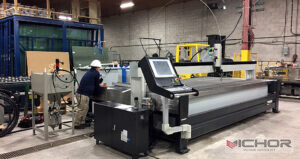
How Does Waterjet Cutting Garnet Improve Precision and Efficiency in Manufacturing?
Waterjet cutting garnet is a critical component in modern manufacturing processes, offering a unique blend of precision, versatility, and environmental benefits. This method utilizes a high-pressure stream of water mixed with garnet abrasive to cut through a wide range of materials, from metals to composites. In this article, we will delve into the specifics of waterjet cutting garnet, exploring its mechanisms, advantages, applications, and more. By understanding the role of waterjet cutting garnet, industries can optimize their operations for better outcomes.
What Is Waterjet Cutting Garnet?
Waterjet cutting garnet refers to the use of garnet abrasive particles in a waterjet cutting system. Garnet, a naturally occurring mineral, is known for its hardness and durability, making it an ideal abrasive for cutting applications. In waterjet cutting, garnet is mixed with a high-velocity water stream to erode materials accurately. This process is highly efficient and is used across various industries due to its ability to handle diverse materials without heat-affected zones. The waterjet cutting garnet method ensures clean cuts with minimal waste, contributing to cost savings and environmental sustainability. By leveraging the properties of garnet, this technique provides a reliable solution for complex cutting tasks.
How Does Waterjet Cutting with Garnet Work?
The process of waterjet cutting with garnet involves several key steps. First, a high-pressure pump pressurizes water to levels exceeding 60,000 psi. This pressurized water is then forced through a small nozzle, creating a supersonic stream. At this point, garnet abrasive is introduced into the stream via an abrasive delivery system. The mixture of water and garnet particles impacts the material surface, eroding it through micro-cutting and erosion mechanisms. The waterjet cutting garnet system allows for precise control over cutting speed and depth, enabling intricate designs and shapes. This method is particularly effective because garnet’s sharp edges enhance the cutting action without generating heat, preserving material integrity.
Advantages of Using Garnet in Waterjet Cutting
One of the primary benefits of waterjet cutting garnet is its versatility. It can cut virtually any material, including metals, stone, glass, and plastics, without altering their inherent properties. Additionally, waterjet cutting garnet produces no heat-affected zones, reducing the risk of material distortion or hardening. This leads to higher quality finishes and fewer post-processing requirements. Another advantage is the environmental friendliness of garnet; it is non-toxic and can often be recycled, minimizing waste. Cost-effectiveness is also a key factor, as waterjet cutting garnet systems have lower operational costs compared to other methods like laser or plasma cutting. Overall, waterjet cutting garnet enhances efficiency and precision in manufacturing.
Applications of Waterjet Cutting Garnet in Various Industries
Waterjet cutting garnet finds applications in numerous sectors due to its adaptability. In the aerospace industry, it is used to cut composite materials and alloys with high precision. The automotive sector relies on waterjet cutting garnet for shaping parts and components without thermal damage. In architecture and design, it enables the creation of intricate patterns in stone, tile, and glass. The manufacturing industry uses waterjet cutting garnet for prototyping and production, thanks to its ability to handle thick materials. Even the food processing industry employs similar principles for cutting soft materials. The widespread use of waterjet cutting garnet underscores its importance in modern technology.
Why Is Garnet the Preferred Abrasive for Waterjet Cutting?
Garnet stands out as the preferred abrasive in waterjet cutting due to its unique physical and chemical properties. It has a Mohs hardness of 7-8, making it hard enough to cut through tough materials yet friable enough to break down safely, reducing the risk of nozzle wear. Unlike synthetic abrasives, garnet is naturally occurring and eco-friendly, aligning with sustainability goals. The angular shape of garnet particles ensures efficient cutting action, leading to faster processing times. Moreover, waterjet cutting garnet offers a longer lifespan compared to other abrasives, resulting in lower consumption and cost savings. These factors collectively make waterjet cutting garnet a superior choice for many applications.

Environmental and Safety Considerations of Waterjet Cutting Garnet
When using waterjet cutting garnet, environmental and safety aspects are crucial. Garnet is inert and non-toxic, posing minimal health risks to operators. However, proper ventilation and protective gear are recommended to handle airborne particles. In terms of environmental impact, waterjet cutting garnet systems often incorporate water recycling and garnet reclamation processes, reducing waste and water usage. The absence of hazardous byproducts, such as fumes or chemical residues, makes this method safer than thermal cutting techniques. By adhering to best practices, industries can leverage waterjet cutting garnet while maintaining high safety and environmental standards.
Maintenance and Cost Factors in Waterjet Cutting Garnet Systems
Maintaining a waterjet cutting garnet system involves regular checks on nozzles, pumps, and abrasive delivery mechanisms to ensure optimal performance. Nozzle wear is a common issue, but using high-quality garnet can extend their lifespan. The cost of waterjet cutting garnet includes initial setup expenses, abrasive consumption, and energy usage. However, the efficiency and durability of garnet often lead to long-term savings. Compared to other methods, waterjet cutting garnet requires less frequent abrasive replacement and lower maintenance costs, making it a financially viable option for many businesses.
Frequently Asked Questions
Q1: What is waterjet cutting garnet used for?
A1: Waterjet cutting garnet is used as an abrasive in waterjet cutting systems to precisely cut a variety of materials, including metals, ceramics, and composites, without generating heat or altering material properties.
Q2: How does waterjet cutting garnet compare to other abrasives?
A2: Waterjet cutting garnet is often preferred over other abrasives due to its natural hardness, eco-friendliness, and cost-effectiveness. It provides efficient cutting with minimal wear on equipment, unlike synthetic alternatives.
Q3: Is waterjet cutting garnet environmentally safe?
A3: Yes, waterjet cutting garnet is environmentally safe as garnet is a non-toxic, natural mineral. It can be recycled in many systems, reducing waste and supporting sustainable manufacturing practices.
Q4: What materials can be cut using waterjet cutting garnet?
A4: Waterjet cutting garnet can cut a wide range of materials, such as steel, aluminum, glass, stone, plastics, and rubber, making it versatile for industries like aerospace, automotive, and construction.
Q5: How often should garnet be replaced in a waterjet cutting system?
A5: The replacement frequency for waterjet cutting garnet depends on usage and system efficiency, but it typically lasts longer than other abrasives. Regular monitoring and recycling can extend its life, reducing the need for frequent replacements.
continue reading
Related Posts
- 1469 words7.4 min read
- 1821 words9.2 min read
- 1691 words8.5 min read



